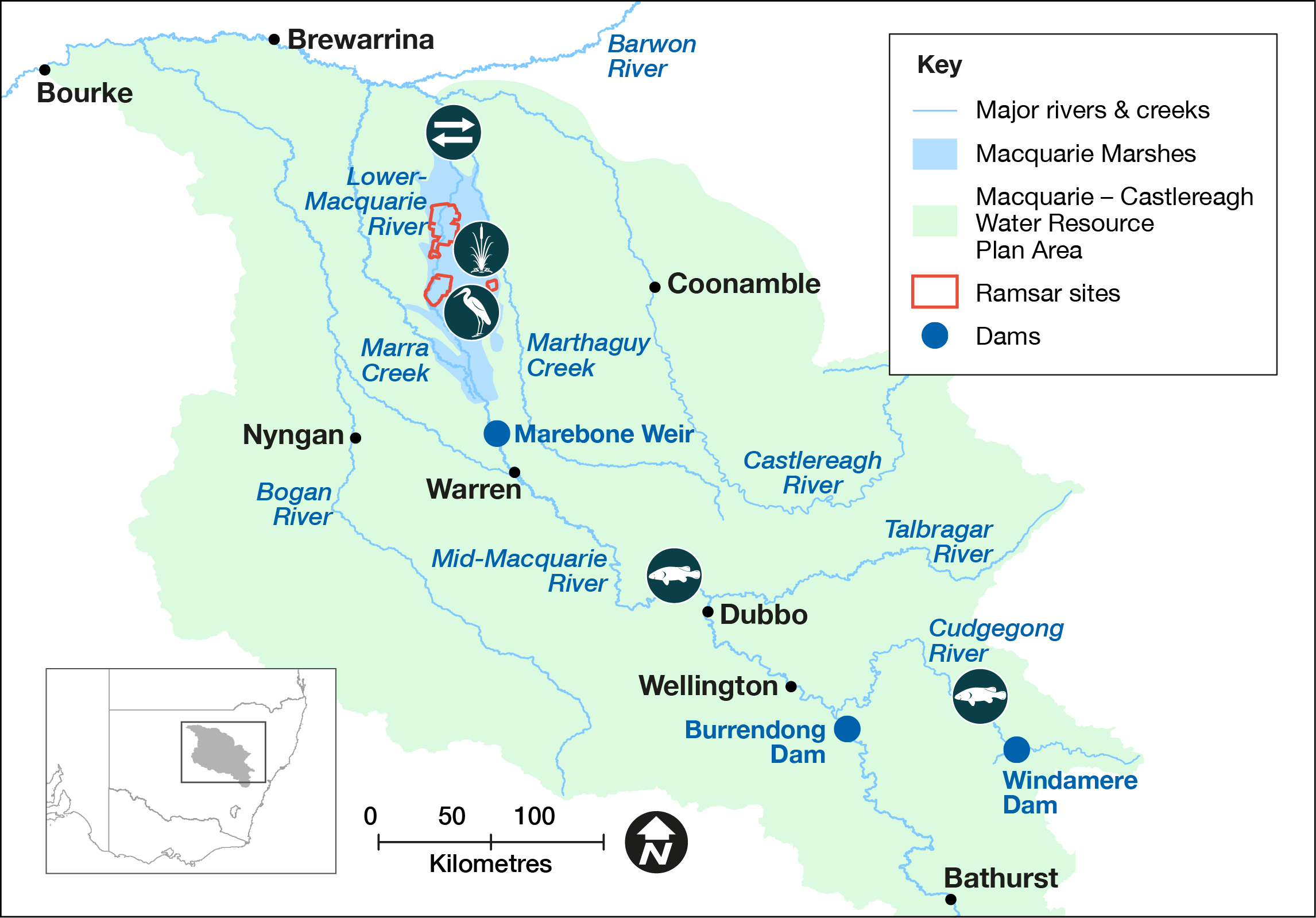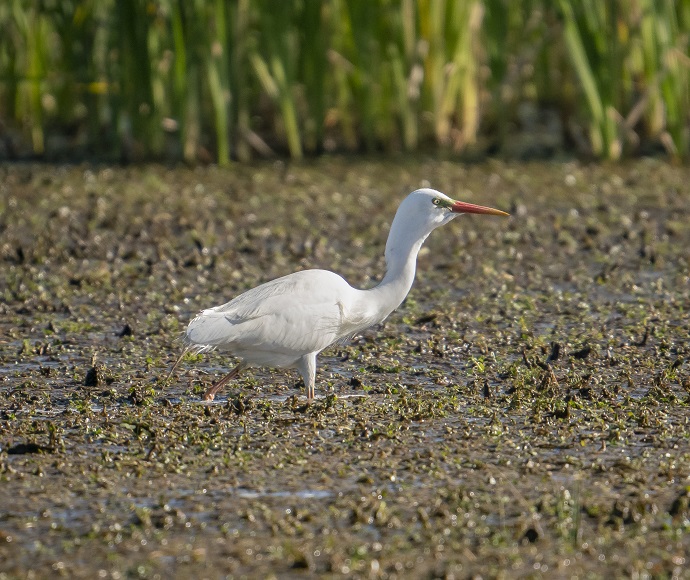The Macquarie–Castlereagh catchment covers more than 75,000 square kilometres in the State’s central west. It extends from the Blue Mountains to the Barwon River plains, with major tributaries including the Cudgegong, Talbragar and Bell rivers.
The catchment is home to the iconic Macquarie Marshes – one of the largest semi-permanent wetland systems and colonial waterbird breeding sites in inland Australia.
The catchment supports important cultural values for Wiradjuri and Ngemba-Wayilwan people.
Water for rivers and wetlands
Increased rainfall and river flows since January 2020 have supported the recovery from the 2017–2019 drought.
Both planned and held accounts will be at 100% from 1 July 2022, with 334 gigalitres (GL) of the Department of Climate Change, Energy, the Environment and Water (the department) and Commonwealth Environmental Water Holder carryover available for the 2022–23 water year. Further rainfall could lead to the possibility of additional allocations early in the water year.
In 2022–23, water managers will target ongoing drought recovery outcomes for native fish, wetland vegetation, waterbirds and flow connection to the Barwon River.
Subject to regulated Water Sharing Plan amendment, a discretionary Environmental Water Allowance may be created in the regulated Cudgegong River in late 2022. This water has been managed to date as a rules-based translucent dam release. Water managers will plan the management of this allowance later in the year.
Weather and water forecast
The El Niño–Southern Oscillation (ENSO1) outlook remains at La Nina, with a return to neutral ENSO during winter, meaning average or wetter conditions are likely. Further, the Bureau of Meteorology has forecast average temperatures in the Macquarie catchment.
Water managers have prepared watering plans that consider a range of weather and water availability scenarios. As at April 2022, conditions in the Macquarie– Castlereagh catchment are ‘wet’.
1. ENSO: The interaction between the sea surface and atmosphere over the Pacific Ocean which results in dryer or wetter conditions (El Nino or La Nina).
Resource availability scenario
Current forecast: Wet
| Conditions | Main aim | Other aims |
|---|---|---|
| Very dry | Protect | Avoid critical loss Maintain key refuges Avoid catastrophic events |
| Dry | Maintain | Maintain river functioning Maintain key functions of high priority wetlands |
| Moderate | Recover | Improve ecological health and resilience Improve opportunities for plants and animals to breed, move and thrive |
| Wet to very wet | Enhance | Restore key floodplain and wetland linkages Enhance opportunities for plants and animals to breed, move and thrive |
Key planned actions for 2022–23
Waterbirds
An inundation event in the Macquarie Marshes during spring 2022 will provide habitat for waterbirds, including first-year birds from colonies in the Macquarie Marshes and wider Basin.
Native fish
Water managers will use water for the environment to target native fish populations in the mid Macquarie Wambuul River.
The fish species targeted will depend upon conditions over spring. Flow generalists like Murray cod and eel-tailed catfish will be targeted if other river flows are relatively stable, while flow specialists including golden perch will be supported if conditions remain wet with variable flows.
Vegetation
Water managers will deliver environmental flows during spring 2022 to support drought recovery for a third year. These flows will target the inundation of the inner 9,000 to 19,000 hectares of the Macquarie Marshes at a minimum.
Some riparian vegetation along the mid and lower Macquarie Wambuul River will be supported where flows are present. These flows will also recharge shallow groundwater systems and sustain vegetation that rely on this water source.
Connectivity
Connectivity to the Barwon has been consistent through 2021 and 2022. With a wetted Macquarie Marshes, it is expected spring flows in 2022 will provide extended flow connection along the lower Macquarie River to the Barwon River.

Map of proposed annual priority targets in the Macquarie–Castlereagh Water Resource Plan area 2022–23.
The department is supporting the health and resilience of rivers and wetlands by delivering water for the environment where and when it is needed. We use the best available science, management expertise and experience to manage water across the landscape. This statement of annual priorities identifies the waterways and wetlands that are likely to receive water.
Our decision-making process considers:
- expected availability of water in the coming year
- conditions of the previous year
- current health of the plants and animals in these ecosystems.
Community-based Environmental Water Advisory Groups (EWAGs) provide feedback and advice to the department on the management of water for the environment.
The NSW Government works with the Commonwealth Environmental Water Holder to manage water in the catchment.
Water for the environment is a share of the water in dams and rivers that is set aside to support the long-term health of local rivers, creeks and wetlands. Healthy rivers carry water to homes, farms, schools and businesses. Rivers and wetlands are important cultural and spiritual sites for Aboriginal people, as well as the broader community.
Planned environmental water
| Source | Maximum volume available (gigalitres) | Volume expected 1 July under current conditions (gigalitres) |
|---|---|---|
| Macquarie River Environmental Water Allowance | 160 GL general security equivalent | 160 GL |
| Cudgegong River Environmental Water Allowancee | 11.4* GL general security equivalent | Approximately 11 GL ‘Residual Water’ made available at Water Sharing Plan commencement |
Water licenced to New South Wales
| Source | Maximum volume available (gigalitres) | Volume expected 1 July under current conditions (gigalitres) |
|---|---|---|
| General security | 48.4 GL | 48.4 GL |
| Supplementary | 1.4 GL | 1.4 GL |
| Unregulated | 2.9 GL | 2.9 GL |
Water licenced to the Commonwealth
| Source | Maximum volume available (gigalitres) | Volume expected 1 July under current conditions (gigalitres) |
|---|---|---|
| General security | 126.2 GL | 126.2 GL |
| Supplementary | 8.3 GL | 8.3 GL |
* This is a combination of current allocations and future forecast allocations.
Notes: This is an indicative summary of expected volumes to be available. For further detail and information on available volumes you can contact the region via the Department of Climate Change, Energy, the Environment and Water on 1300 361 967.
1 gigalitre = 1000 megalitres; 2.5 megalitre = 1 Olympic swimming pool.

The Macquarie–Castlereagh catchment covers more than 75,000 square kilometres,
More about ...
- Long-term water plans
- Macquarie-Castlereagh Long-Term Water Plan
- Water Sharing Plan for the Macquarie and Cudgegong Regulated River Water Sourceopens a new window
- Murray Darling Basin Authority
- Murray Darling Basin Planopens a new window
- Commonwealth Environmental Water Office – Macquarieopens a new window
More information on planned and past watering events
- Macquarie–Castlereagh Catchment – Water for the Environment: Annual Priorities 2021–22
- Macquarie-Castlereagh catchment: Annual environmental watering priorities 2020–21
- Macquarie Castlereagh: Annual environmental watering priorities 2019–20
- Macquarie-Castlereagh catchment: Annual Environmental Watering Priorities 2018–19
- Macquarie-Castlereagh: Annual environmental watering priorities 2017–18
- Macquarie-Castlereagh Water Resource Plan Area: Statement of annual environmental watering priorities 2016–17
- Macquarie-Castlereagh Water Resource Plan Area: Statement of annual environmental watering priorities 2015–16
- Macquarie Marshes Adaptive Environmental Management Plan
- Water for environment outcomes 2021–22
- Use of water for the environment in NSW: Outcomes 2020–21
- Use of water for the environment in NSW: Outcomes 2019–20
- Use of water for the environment in NSW: Outcomes 2018–19
- Use of water for the environment in NSW: Outcomes 2017–18